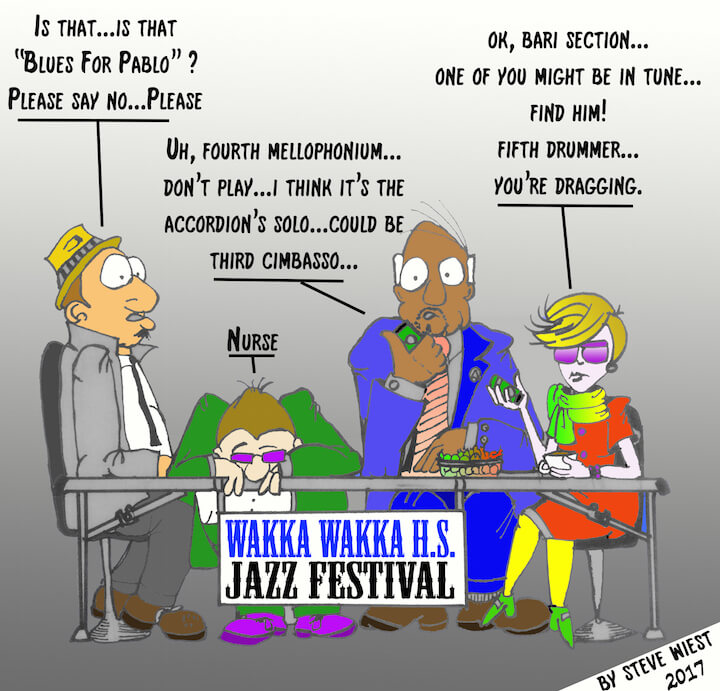Dealing With Weird Instrumentation and Improving Improvisation…It’s Real Easy!
by Steve Wiest
When I have the honor of taking part in a middle school, high school or university jazz festival as an adjudicator, I am presented with an all-too-common list of perplexing situations:
- Big Bands with bizarre instrumentation (REALLY bizarre!)
- Virtuoso charts that are WAY beyond the developmental level of the students, causing them all to crash and burn as they–the heroic young musicians–attempt unsuccessfully to stay afloat. (It’s heartbreaking to watch.)
- An army of young people who seem to have a gift for finding the least successful series of notes that can be played at any given moment–an almost metaphysical misuse of rhythmic, melodic and harmonic composition as they attempt to “improvise.”
- Very, very few (precious few) bands that have an internal sense of time, rhythm, swing feel and bebop phrasing. To call upon, paraphrase and underline the established Ellingtonian adage… it STILL don’t mean a thing if it ain’t got that!
- And a wonderful (albeit it WAY too low in numbers) program or two that really “gets it” as evidenced by their chart selection, time feel, vocabulary and grasp of the tradition.
What to do? The solution is, of course, quite simple in nature–but a life’s study in the doing. (Side effects may include: successful careers, huge fun playing classic and modern jazz, a healthy glow that comes from truly learning a rewarding art form and starting to actually sound like a jazz musician. This offer void in some programs… your results may vary.)
Let’s go over these perplexing situations one-by-one:
Bizarre Instrumentation
There are many well-meaning directors in the jazz education community who have adopted the approach of “I allow everyone who wants to play to be in my big band!” While I understand and applaud the good place that this comes from, if you end up with seventeen alto saxophones, a bari sax section, five tenors, three solid body Stratocaster guitars with whammy bars, a synth bass player, three bad pop singers, two drum set players with five extra percussionists, ten trumpets (7 Bb trumpets, two flugels and a cornet) a euphonium, a marching French horn and a violinist…do NOT program Bob Brookmeyer’s “Get Well Soon” …just sayin’!
While that is of course an exaggeration (Hey, it is to laugh, no?) it really isn’t that much of an exaggeration from what I have actually seen. So if you find yourself in a situation where the politics, logistics or realities of your program dictate that you have a non-standard instrumentation for your big band, then please don’t choose material that is written for a specific instrumentation and just have everyone “make due.” There are many other things you can do that will yield wonderful results!
- If you took that arranging class in your undergrad and had fun with it, put it into action! Take a simple blues head or accessible jazz standard and write it up for your unusual instrumentation. Then play great versions of the original for the students to get the idea of how to play the basic tune. You may just come up with the “new sound!” And you will find yourself with the hippest book in town. A bit of work for you, so get it done in the summer before things get hectic. Then just add a chart or two every semester. Then publish them (you’ll make FIVES of dollars!!!)
- Buy The Real Easy Book! My pal Denis DiBlasio describes how great this can be as only he can: https://www.youtube.com/watch?v=TevufkT1w5Y
I HIGHLY recommend that you check out this video and then buy a big batch of these books. Here’s what you can do with them:
- Instantly have cool harmony for a bunch of great tunes. Everything in the key of specific instruments.
- You can also work out shout choruses, intros and endings…all included!
- You can refer to YouTube recordings for student research, so that they can learn to swing on these tunes!
- Choose some blues heads, learn them yourself, and then dictate them to the students. They can first learn the lines in unison, and then you can teach them some harmony and counter lines. In this way, they are assimilating swing, learning to memorize and they will sound GREAT! Imagine how hip your band will feel as they come out on stage with NO CHARTS (“We don’t need music stands, man.”) And there is NO way anyone can have a last minute “I lost my music” emergency-unless they lose consciousness. (But that is the subject for an entirely different article.) Plus your students will have real ownership in what they are doing and will actually practice! Try it–you’ll love it!
Where, you may ask, can I get some of these cool blues heads? (melodies and chord progressions from standard jazz blues tunes) Happily, there are many wonderful artists who have been trained at some of the best programs in the world who are out there making a living as virtuoso musicians while also being incredible educators. One such hero is Dan Miller, trumpet artist extraordinaire and one of the best clinicians I have ever worked with. Dan has a website that simply has everything that you need to get going. His list of blues heads alone is priceless! Check him out here: http://www.danmillerjazz.com/ Specifically, dig his one-stop-shopping blues heads, articles and other goodies student resource page: http://www.danmillerjazz.com/studentresourcesgeneral.html
MAN! If I would have had access to this as a young student…I might have become somebody!
These ideas are traditionally considered for small groups (start a small group program if you don’t have one…that is where the basics of improvisation and arranging can really be acquired!) However, these principles can also work for the big band…especially the non-standard instrumentation ensemble.
Bad Improvisers
I’ll bet you’ve heard this story: A student steps up to the mic to play on a Bb blues at a jazz camp during a session led by a veteran master of the art. The student launches into what can only be described as a great travesty against nature and something that is at odds with all the rules of physics (3rd and 7th abuse abounds, no clue as to what key he is playing, absolutely NO use of vocabulary of ANY era or style, and… no time!) Upon the conclusion of his solo, the veteran asks the student:
Veteran: “Man! What was that!?”
Student: “DUDE, I was just playing what I feel!”
Veteran (shouting): “Well then feel something in Bb!”
(The above story has been edited for family audiences.)
Yep, jazz is a language, with all the nuance and syntax of a spoken language. The vocabulary is a means to an end, of course, with the end results being governed by the individual’s personal gifts and how efficiently they practice… but the language must be learned and a story must be told. Consider what these members of the Jazz Justice League have to say about it:
“You have to work a long time before you can sound like yourself.”
–Miles Davis
Regarding the process of becoming an improviser:
“Emulate, Assimilate, Innovate.”
–Clark Terry
So, what to do? Well, make sure that YOU can improvise at the level that you want your students to improvise, and then demonstrate it to them. Also, the students must transcribe. This approach applies to instrumentalist and vocalists. Consider CT’s all-important directive quoted above. I think of it this way:
- Emulate: listen to the greats! Choose someone that you LOVE and listen, copy, imitate, polish, shed…repeat as needed. Become that artist: time, style, nuance and tone.
- Assimilate: take the vocabulary that you have learned and transpose it to other keys, put it into multiple tunes, put those tunes into other keys, record yourself, transcribe and analyze yourself. Pick up the book A Practical Approach To Jazz Improvisation: The David Hazeltine Approach by Ben Markley (Jamey Aebersold’s site http://jazzbooks.com/) and USE it! In short: SHED (practice) There is no shortcut. Don’t worry if you start sounding too much like Clifford Brown or Sonny Stitt–that is NOT a problem when you are developing your own voice. (Actually, that is never a problem!)
- Innovate: This is what will happen when you become a master of the vocabulary: time, rhythm, nuance, style and note-choice. Once you understand and acquire the language you will free yourself to synthesize it all together so that your own voice emerges. The same process as a person who develops a great written and spoken vocabulary who goes on to become a major innovative author or playwright–same deal! You will be able to express your own approach fully.
And these few simple points will take care of your weird instrumentation and heinous improviser problem…guaranteed! No doubt about it. These ideas are not complex, but they take a great deal of dedication and work to make happen. I have found that getting to the heart of the matter and applying Occam’s Razor–AKA the law of parsimony (“The simplest solution is quite often the best solution”) is the way to go. There is no mystery here; there is only hard work and spectacular results.
I leave you with a quote form one of my Yodas (Yodi?) the great Slide Hampton. Slide is a notoriously humble man, and for a while I was just trying to get him to accept a compliment! Well, I was sure I had him when he received a Grammy. Here’s how it went:
Me: “Slide! Congratulations on your Grammy! It must really feel good to get some recognition finally at this point in your career.”
Slide: “Yes, Steve, I am quite excited at this point in my life because I think that I finally know exactly what it is that I need to practice.”
WOW! Here was one of the greatest living composers-arrangers-and improvisers of our music telling me that he was excited to finally know what to practice! This was akin to one more quote…this time from the master-of-masters Dizzy Gillespie:
“The more I learn, the more I learn there is to learn.”
May we all be so lucky as to realize this and to apply it to all that we do.
Steve Wiest is the Co-Chair of Jazz Studies at The University of Denver’s Lamont School of Music (https://www.jazzatlamont.com/) Former director of the One O’Clock Lab Band (UNT) Grammy-nominated composer and trombonist with Vinyl Hampdin (https://www.vinylhampdin.com/) Edwards clinician, cartoonist and sci-fi author (http://steve-wiest.com/)


